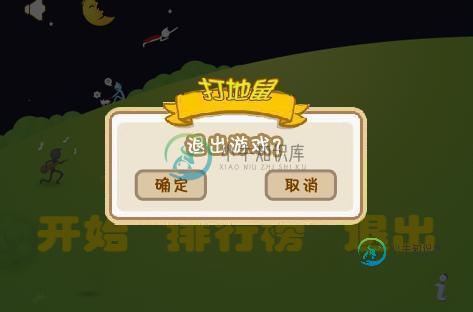Android编程之自定义AlertDialog(退出提示框)用法实例
本文实例讲述了Android编程自定义AlertDialog(退出提示框)用法,分享给大家供大家参考,具体如下:
有时候我们需要在游戏或应用中用一些符合我们样式的提示框(AlertDialog)
以下是我在开发一个小游戏中总结出来的.希望对大家有用.
先上效果图:

下面是用到的背景图或按钮的图片
经过查找资料和参考了一下例子后才知道,要实现这种效果很简单.就是在设置alertDialog的contentView.
以下的代码是写在Activity下的,代码如下:
public boolean onKeyDown(int keyCode, KeyEvent event) {
// 如果是返回键,直接返回到桌面
if(keyCode == KeyEvent.KEYCODE_BACK || keyCode == KeyEvent.KEYCODE_HOME){
showExitGameAlert();
}
return super.onKeyDown(keyCode, event);
}
private void showExitGameAlert() {
final AlertDialog dlg = new AlertDialog.Builder(this).create();
dlg.show();
Window window = dlg.getWindow();
// *** 主要就是在这里实现这种效果的.
// 设置窗口的内容页面,shrew_exit_dialog.xml文件中定义view内容
window.setContentView(R.layout.shrew_exit_dialog);
// 为确认按钮添加事件,执行退出应用操作
ImageButton ok = (ImageButton) window.findViewById(R.id.btn_ok);
ok.setOnClickListener(new View.OnClickListener() {
public void onClick(View v) {
exitApp(); // 退出应用...
}
});
// 关闭alert对话框架
ImageButton cancel = (ImageButton) window.findViewById(R.id.btn_cancel);
cancel.setOnClickListener(new View.OnClickListener() {
public void onClick(View v) {
dlg.cancel();
}
});
}
以下的是layout文件,定义了对话框中的背景与按钮.点击事件在Activity中添加.
文件名为 : shrew_exit_dialog.xml
<?xml version="1.0" encoding="utf-8"?> <RelativeLayout xmlns:Android="http://schemas.android.com/apk/res/android" android:layout_height="wrap_content" android:layout_width="wrap_content"> <!-- 退出游戏的背景图 --> <ImageView android:id="@+id/exitGameBackground" android:layout_centerInParent="true" android:layout_height="wrap_content" android:layout_width="wrap_content" android:src="@drawable/bg_exit_game" /> <!-- 确认按钮 --> <ImageButton android:layout_alignBottom="@+id/exitGameBackground" android:layout_alignLeft="@+id/exitGameBackground" android:layout_marginBottom="30dp" android:layout_marginLeft="35dp" android:id="@+id/btn_ok" android:layout_height="wrap_content" android:layout_width="wrap_content" android:background="@drawable/btn_ok" /> <!-- 取消按钮 --> <ImageButton android:layout_alignBottom="@+id/exitGameBackground" android:layout_alignRight="@+id/exitGameBackground" android:layout_marginBottom="30dp" android:layout_marginRight="35dp" android:id="@+id/btn_cancel" android:layout_height="wrap_content" android:layout_width="wrap_content" android:background="@drawable/btn_cancel" /> </RelativeLayout>
就这样经过了以上几步,就可以实现自定义AlertDialog的效果了. 用同样的思路可以实现其它更复杂的效果.
希望本文所述对大家Android程序设计有所帮助。
-
本文向大家介绍Android仿IOS自定义AlertDialog提示框,包括了Android仿IOS自定义AlertDialog提示框的使用技巧和注意事项,需要的朋友参考一下 本文介绍的仿IOS对话框的实现,先来看一下效果图 具体代码如下: 布局文件view_alertdialog.xml alertdialog_left_selector.xml alertdialog_right_select
-
本文向大家介绍Android编程自定义AlertDialog样式的方法详解,包括了Android编程自定义AlertDialog样式的方法详解的使用技巧和注意事项,需要的朋友参考一下 本文实例讲述了Android编程自定义AlertDialog样式的方法。分享给大家供大家参考,具体如下: 开发的时候,通常我们要自定义AlertDialog来满足我们的功能需求: 比如弹出对话框中可以输入信息,或者要
-
本文向大家介绍iOS自定义alertView提示框实例分享,包括了iOS自定义alertView提示框实例分享的使用技巧和注意事项,需要的朋友参考一下 本文实例为大家分享iOS自定义alertView提示框,先上图,弹框的背景色,按钮背景色,提示的消息的字体颜色都可以改变 利用单例实现丰富的自定义接口 .m文件中初始化控件以及对alertView的控件的属性进行懒加载,确定初始的颜色. 在需要调用
-
本文向大家介绍Android自定义单例AlertDialog详解,包括了Android自定义单例AlertDialog详解的使用技巧和注意事项,需要的朋友参考一下 当Android开发处理错误信息时,经常会以Dialog的形式显示错误信息,但是每次都new一个Dialog,很麻烦,也增加程序的开销,所以今天就分享一种自定义单例AlertDialog 布局文件view_alertdialog.xml
-
本文向大家介绍Android提高之自定义Menu(TabMenu)实现方法,包括了Android提高之自定义Menu(TabMenu)实现方法的使用技巧和注意事项,需要的朋友参考一下 一般使用过UCWEB-Android版的人都应该对其特殊的menu有一定的印象,把menu做成Tab-Menu(支持分页的Menu),可以容纳比Android传统的menu更丰富的内容(Android的menu超过6
-
本文向大家介绍Android AlertDialog实现分享对话框/退出对话框/下载对话框,包括了Android AlertDialog实现分享对话框/退出对话框/下载对话框的使用技巧和注意事项,需要的朋友参考一下 一.摘要 弹窗通常用于提示用户进行某种操作,比如:点击分享按钮,弹窗分享对话框;双击返回按钮,弹窗退出对话框;下载文件,提示下载对话框等等,分享对话框/退出对话框/下载对话框,都可以直

